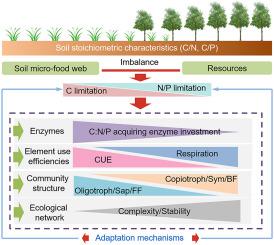Soil Biology and Biochemistry ( IF 9.8 ) Pub Date : 2022-05-06 , DOI: 10.1016/j.soilbio.2022.108698 Bing Li 1, 2 , Yingbin Li 1 , Nicolas Fanin 3 , Xu Han 1, 2 , Xiaofang Du 1, 2 , Hanwen Liu 1, 2 , Yuhui Li 1, 2 , Qi Li 1

|
Stoichiometric imbalance between resources and their decomposers can alter the activity and structure of soil microbial communities and play an important role in regulating nutrient and carbon cycling in terrestrial ecosystems. However, whether and how ecological networks of soil micro-food web change to cope with the stoichiometric imbalance has never been assessed so far. In this study, we tested how the soil micro-food web responded to elemental limitations along a forest-steppe ecotone. We measured several adaptation mechanisms including soil microbial stoichiometry, enzyme activities and the composition of soil microbial and nematode communities. The microbial investment in resource acquisition shifted from nutrient-to C-acquiring enzymes with decreasing soil C:N:P ratios along the forest-steppe ecotone. The shifts in element use efficiencies could be a compensatory way besides enzyme allocation, implemented by microbial communities to cope with stoichiometric imbalance in their substrates. The community structure of soil micro-food web also changed with a decrease in saprotrophic fungi and fungivorous nematodes from the steppe plots towards the forest plots. The co-occurrence networks were less complex and stable with decreasing soil C:N:P ratios, suggesting that trophic interactions were less diverse and C-limitation plays an important role in structuring ecological interactions in soil food webs. Our findings provide insights into how stoichiometric constraints may induce shifts in ecological networks and have important implications for integrating shifts in individual physiological metabolism as well as changes in community composition of soil biota and to better understand and predict soil biogeochemical cycling in terrestrial ecosystems.
中文翻译:

土壤微食物网对元素限制的适应:来自森林草原交错带的证据
资源及其分解者之间的化学计量失衡可以改变土壤微生物群落的活动和结构,并在调节陆地生态系统中的养分和碳循环方面发挥重要作用。然而,迄今为止,尚未评估土壤微食物网的生态网络是否以及如何改变以应对化学计量失衡。在这项研究中,我们测试了土壤微食物网如何响应森林草原交错带的元素限制。我们测量了几种适应机制,包括土壤微生物化学计量、酶活性以及土壤微生物和线虫群落的组成。随着森林草原交错带土壤 C:N:P 比的降低,微生物对资源获取的投资从养分获取酶转移到了获取碳的酶。除了酶分配之外,元素使用效率的变化可能是一种补偿方式,由微生物群落实施,以应对其底物的化学计量失衡。土壤微食物网的群落结构也随着从草原地块向森林地块的腐生真菌和食真菌线虫的减少而发生变化。随着土壤 C:N:P 比率的降低,共现网络不太复杂和稳定,这表明营养相互作用的多样性较低,而 C 限制在构建土壤食物网中的生态相互作用中起重要作用。











































 京公网安备 11010802027423号
京公网安备 11010802027423号